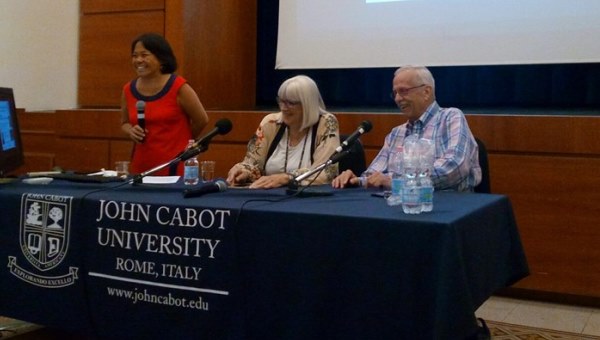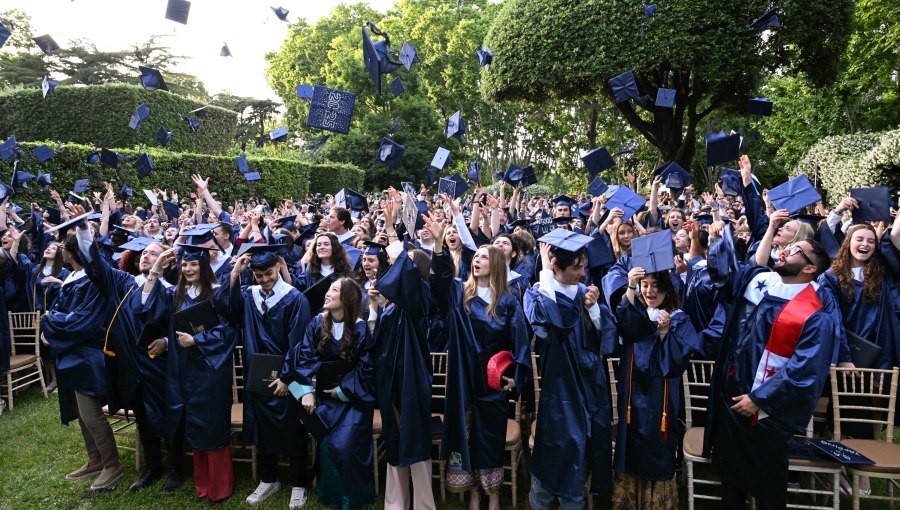The Role of Youth in a Fake News World: JCU Welcomes Judy Muller and George Lewis
What is the role of youth in a fake news world? On September 13, JCU Visiting Professor Deanna Lee discussed this topic with Judy Muller, Professor Emeritus, USC Annenberg School of Communication and Journalism, and long-time ABC News, CBS News and NPR national correspondent and columnist, and George Lewis, 40-year NBC News correspondent.
The event was part of the Office of the Dean of Academic Affairs Lecture Series at John Cabot University.
All three journalists shared the opinion that journalism offers incredible opportunities for young people today. If you care about democracy and freedom of speech, there has never been a more appropriate time to get involved in news literacy.
“When you have world leaders calling the media ‘the enemy of the people’ and journalists [continuing to be] imprisoned in certain countries for factual reporting, the world needs to sit up and pay closer attention,” said Muller. When recent reports of an [under]estimated 3,000 deaths in Puerto Rico are called fake news, “an assault on truth is taking place,” added Lewis. This estimate is low, he explained, because it doesn’t take into account the aftermath deaths from a natural disaster such as those lives lost as a consequence of damaged infrastructure, leading to missed dialysis treatment, to name just one example.
Muller observed how the news sources most widely used for her students are not the printed word, radio, or television — where watching the news used to be a daily activity. Instead, they look to podcasts, social media, and other online sources for their information. So, she teaches them to move between mediums: “Intelligent people know where to get intelligent facts. The problem is seeking out the facts. When asked, ‘Where do you get your news?’ many people answer, ‘Where I find what I like.’ That’s living in an information bubble, and it’s what we all need to avoid.”
As a journalist, Muller added, it’s essential to be verifiable, accountable, trustworthy and ethical. You need to know how to listen with empathy and to interview people of all different perspectives.
NEWS LITERACY AND CRITICAL THINKING: THE “SMELL” TEST
Who can you trust? The panelists discussed the responsibility of the reader/consumer of news to be critical and aware, versus consuming news as a passive activity. Ask yourself key questions, said Muller. In her classes, she has her students use the “SMELL Test” by John McManus for identifying fake news, which she underscores is not just something you simply disagree with, but that which has been designed to deceive. The test is an acronym reminding us what to ask ourselves:
S = Source. What is the source of this information?
M = Motivation. What is the motivation behind this piece of news? Why has this been presented?
E = Evidence. What evidence has been provided?
L = Logical. Does this make sense? Does it seem plausible? Are the comparisons presented reasonable?
L = Left out. What has the writer left out? Are the perspectives of all stakeholders included or considered?
HOW DO YOU VERIFY THE FACTS?
The panelists pointed out many fact-checking websites that can help, including Snopes.com, FactCheck.org, and PolitiFact.com. Among other rules of thumb to follow: 1) Check before sharing. Sharing isn’t a passive activity. You have a responsibility, which many young people do know and worry about. Deanna Lee pointed to a study showing that half of teens are concerned about sharing fake news and misinformation. 2) Use critical thinking to find trustworthy sources: learn to recognize and aggregate reliable news sources.
WHERE DO WE START TEACHING NEWS LITERACY?
Training toward critical thinking can start with learning to read…at the elementary school level, said Muller. She shared the story of an educator she met at a conference who developed a Lesson Module on News Literacy for this age group based on stories of Peter Rabbit by Beatrix Potter.
WHAT CAN WE DO TO REDUCE THE PRESENCE OF FAKE NEWS ON THE INTERNET?
Muller and Lewis agreed we might define fake news as anything produced in order to deceive. Not just “something you disagree with.”
Recent European Commission plans to require social media sites to remove fake news within 24 hours is a step in the right direction, but “good luck with that!” says Lewis.
Asked by Lee about concerns surrounding the need for even-handedness in higher education, which is often criticized for being left-leaning, Lewis pointed out how some sides to a story interfere with the truth. As has long been true in news coverage, there is no obligation to give equal exposure to information that is contrary to proven fact. Lewis cited climate change deniers as a key case in point.
LISTENING TO PEOPLE IN A NON-JUDGMENTAL WAY
The participants discussed the surprise of journalists after the 2016 US elections, who asked themselves “How did we miss this? How did it happen that we didn’t know this was coming? Where did we go wrong?” What they realized, that there was a significant sector of American voters who felt dissatisfied and disenfranchised, was something Muller, the author of a book on the power and importance of small town newspapers around the country, has been working on for some time. She described a project for USC Annenberg’s journalism students that she led in a small town in Utah, a Rural Reporting Initiative two-week course aimed at “bursting the bubble”—encouraging students to get out there and talk to people, or, more importantly, to listen to people. The area is populated (about 50%) by white, Mormon, predominantly Trump supporters, people from very different backgrounds than the students. The rest is Navajo. In the course of this initiative, students learned empathetic, non-judgmental interviewing skills and how to report on people unlike themselves. In addition, they were able to explore first-hand, issues such as how gerrymandering affects election results.
The students learned to listen to people without bias and to tell their story in a factual way. This often takes courage when you’re reporting about your neighbors, Muller pointed out. But, as always, the aim is truth reached by listening and effective reporting of a story
QUESTIONS FROM STUDENTS IN THE AUDIENCE:
There’s so much information out there. How can one possibly take it in and how is the proliferation of fake news exacerbated by this incredible abundance of information?
Sometimes you have to “Turn it off!” says Muller. Positive mental health requires it, she declared, citing the effects social media can have on the body’s production of dopamines. Instead, go for a walk, sit in the park and listen to the birds. Experience a 48-hour blackout from social media and internet, which Muller requires of her students in order to get back in touch with interpersonal and listening skills. She also suggests examining one story each week and how it is presented differently in different media. And, she warns, be mindful of confirmation bias.
There are also a lot of good, smart news platforms. Lewis pointed toProPublica.org, as well as other radio, podcasts, and blogs, where you can tell people’s’ stories. “Innovate!” he said.
Being a journalist today requires that you use Twitter. It’s an essential source of fast, immediate information, contacts and is a marketing tool. Build your own brand and reputation for being a reliable source who makes wise decision of what to share or not to share.
All three journalists agreed that journalism is still the best job there is. It allows you to cover the world.
How do we get ourselves out of this mess?
Muller suggests an exercise: once a week, talk to someone who’s out of your own information and experiential bubble. Investigate other stories. Share different opinions.
This talk was the second in the Office of the Dean of Academic Affairs Lecture Series. The first was a Conversation with author André Aciman on June 28th at John Cabot University.
Coming up: on Thursday, 18 October, Sreenath “Sree” Sreenivasan, named one of Fast Company magazine’s Most Creative People of the Year 2015, Former Chief Digital Officer (CDO), New York City; former CDO, Metropolitan Museum of Art; former academic administrator and professor at the Columbia University Graduate School of Journalism. Sreenivasan is a leader in social media, having been named one of Ad Age’s 25 media people to follow on Twitter, and one of Poynter Institute’s 35 most influential people in social media.






